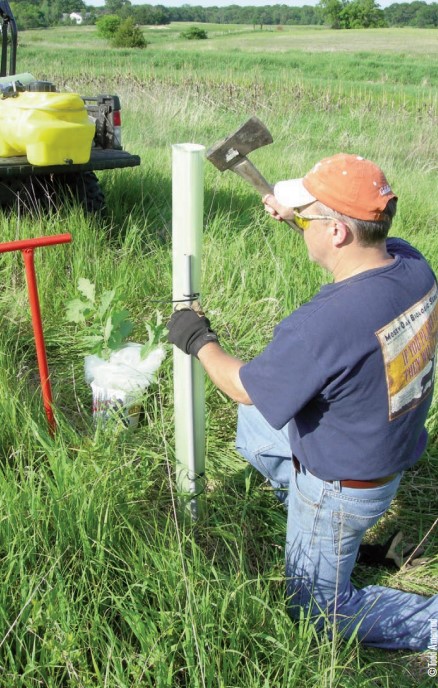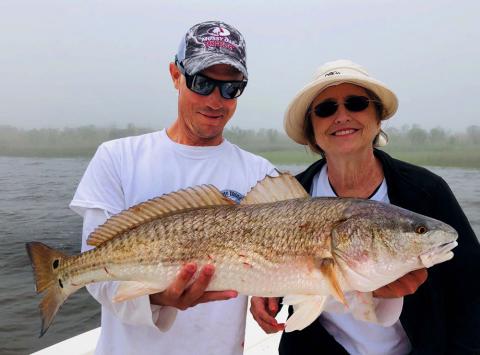Bob Humphrey | Originally published in GameKeepers: Farming for Wildlife Magazine. To subscribe, click here.
Mast orchards represent an alternative or a supplement to food plots as a natural way for attracting and feeding deer. Once planted, most trees are relatively maintenance free. However, planting trees typically represents a much more substantial up-front investment, and it behooves you to protect that investment. Fortunately, that too is largely an up-front endeavor.

Planting
The process begins planting the trees in the ground. We won’t go into too much detail because there’s been plenty written on the subject and likely more to come. Suffice to say, do it right the first time and your trees have a much greater chance of surviving the most critical period in their life.
First, find areas where the soil, slope, moisture and sunlight conditions are best suited to the particular species or variety you’re planting. Next, make sure you break up the soil enough to allow the root system to expand as it grows. Then, provide the recommended fertilizer and water. That should give them a good start, but they still need protection during their early growth stage.
Tubes

mast producing tree is low UNLESS they are protected.
According to experts, depending upon several site-specific
factors, using a Nativ Nurseries Tree Tube can increase tree
survival to over 90%.
Hands down, the best way to protect young trees is with tree tubes. That not only ensures they get past the vulnerable seedling and sapling stages, it also enhances growth rates. Deer seem to key in on tender seedlings and saplings as both a food source and a target to rub their antlers on. Tubes protect the young trees from both, as well as from rodents that might chew on the bases potentially girdling and killing them. Meanwhile, tubes enhance growth by acting like a tiny greenhouse, increasing photosynthetic and transpiration rates. They also trap and direct precious moisture to the root system.
Tree Tubes are efficiently designed to protect young trees. Rather than wood, they use a schedule 40 PVC pipe that can be reused, and facilitates watering and fertilizing. They come pre-threaded with zip ties so once you plant your tree you pound in the pipe, slide the tube over and cinch it tight. The upper part of the tube is vented to allow circulation and prevent the interior from becoming too hot. The bottom is not vented so you can still spray competing vegetation with herbicide.
Competition
In addition to animals, you also need to protect your trees from other plants. They may not kill your trees, but competition for water and soil nutrients can certainly retard growth rates. Mowing, spraying herbicide or some combination of both will minimize competition. Your tubes help here too, acting as both markers and protectors. And reducing grass height and density discourages gnawing rodents. You may also consider placing some garden fabric around the base of your trees at planting time.
Spray Away
Not all spraying is bad. You wouldn’t want to spray herbicide directly on your trees but there are solutions you can apply that will further protect them. Tubes protect seedlings and the lower portion of saplings but deer can still browse anything above the tube. There, growth is often fast enough to avoid too much damage, unless you have high deer densities. Then you should consider spraying the emerging top growth with something like Biologic’s Plot Protector solution.
Insects can also sometimes present problems. Some merely feed on foliage while others can bore into the tree retarding growth or even killing young trees. They’re usually not a problem with healthy trees but preventive maintenance begins with regular inspection. If you discover an infestation, you may need to apply pesticides. A permethrin-based insecticide will address most problems, but you can always check with your county agent for specific applications.
Biologic P2 Plot Protector is a highly concentrated solution scientifically formulated to repel deer and other wildlife through smell and taste. An initial application lasts up to a month, allowing your plants time to establish. This spray will work on the leaves or the fruit. Regular spraying at four-week intervals ensures subsequent protection during the vulnerable stage of growth.
Fooling Flies

With fruit trees, a little preventative maintenance can go a long way. Pesky insects that would consider ruining a good piece of fruit can be captured with a Red Sphere Trap. These red balls are covered with a sticky, non-drying coating that insects fly onto, but can’t escape. The coating will stay sticky over a wide temperature range or wet weather conditions. When flies land to lay eggs in the “decoy fruit," they become permanently trapped. These traps are reusable for many seasons and work great for apple, crabapple and plum trees. It’s recommended to hang one sphere for every 100 pieces of fruit. A trick is to cover the ball with plastic wrap and apply the sticky coating to the plastic wrap rather than the ball. This way they’re much easier to handle and stay nice for longer.
Good Competition
There is an alternative side to competition that can work for you. Obviously you don’t want vegetation that competes with your trees for moisture, nutrients or sunlight. But you might want something that will compete for the deer’s attention as a food source. The more alternate food available the less likely deer will be to key in on young trees - another reason why providing year-round nutrition with food plots is beneficial. It will take the pressure off trees until they’re old enough to fend for themselves.
Beyond the above, the amount and type of protection your trees need becomes very sight-specific. If you have extremely high deer densities you may have to use larger cages or fencing until the trees grow larger. You should conduct routine inspections, even on larger trees, for signs of blight, browse pressure or infestation.
Typically, once the trees reach a stage where they start producing mast the work is over. Now you and your deer can reap the rewards of your labor for years and possibly even generations to come.































